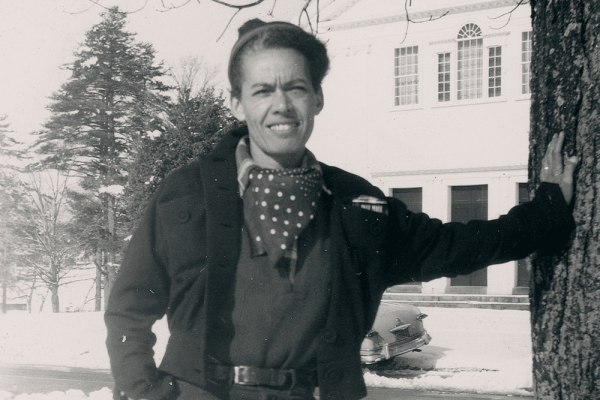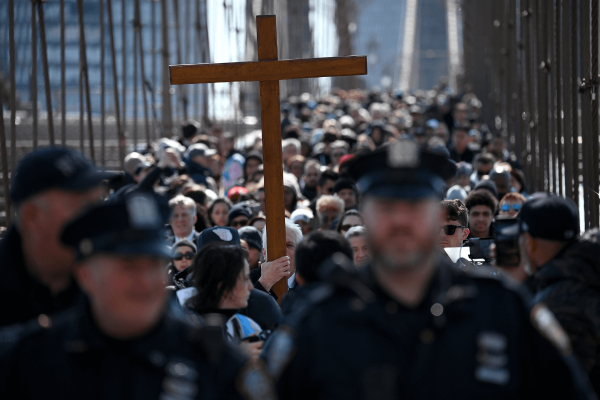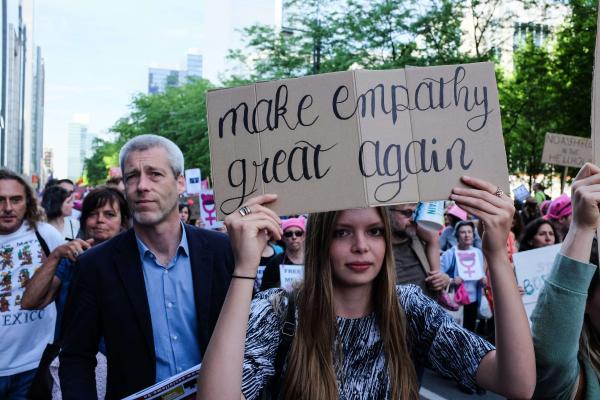An avenging angel stands and beckons, claymore gleaming in his hand. His wings are spread triumphant, framing the radiant halo that encircles his face. Heraldic armor shines in gold, impeccably defined muscles rippling beneath its surface. Except, where the angel’s face should be, President Trump’s face scowls resolutely at the viewer instead. Images like this one have become a disturbingly ubiquitous fixture of the Trump era.
As Trump’s support from many has morphed into worship, memes have become the iconography of the nascent Trump cult. And just as Christian iconography communicates to the viewer important characteristics of our faith, Trump memes are darkly revelatory.
The first trait that becomes clear is how much imagery is starkly eschatological. While this is manifestly true of Trump-as-avenging-angel, it’s also a fixture of less overtly religious pictures. Consider, for example, this meme depicting President Trump dressed as George Washington, standing atop a fiery field. He wields a minigun in one hand, an eagle perched resolutely upon the other. Behind him, the American flag waves bravely, still standing amidst the ruins.
On the one hand, it’s an entirely ridiculous depiction —meme creators often say their art is merely intended as absurdist humor — but it’s difficult to deny the ready link between their apocalyptic themes and the rhetoric by which Trump’s most ardent supporters defend him.
We see this, obviously, in pronouncements like Secretary of State Mike Pompeo’s, when he suggested, “Trump may be the modern-day savior of the Jewish people,” but spend enough time on Twitter — or internet comments sections — and you’ll see this refrain repeated time and time again. People talk about how Trump is saving a country teetering on the brink of chaos, how he is “taking our nation back.” The president nourishes this belief through propaganda like his inaugural address, in which he promised to put an end to the American carnage. Indeed, threat and violence are another near constant fixture of the Trump digital ecosystem. If you were to only listen to Trump supporters describe the brutality of American cities, you would have no idea that violent crime was at near thirty-year-lows. If you only hear Fox News commentators describe the “border crisis,” you’d be shocked to know that border crossings have steadily decreased for 18 years.
Instead, an imaginary hellscape is marshalled and used as justification for the cruelty of Trump administration policies, and serves as an ideological background for the violence of presidential iconography. Consider this meme, where the president stands atop a rolling tank — emblazoned with his name — assault rifle in hand. For good measure, explosions frame his visage and an eagle fires a machine gun in the background.
While, obviously, not everyone who spreads these memes is endorsing violence, its undeniable that some of the president’s supporters view them as a roadmap for the kind of radical action they believe it will take to “make America great again.” Cesar Sayoc, for example, affixed this very image to the window of his van before he mailed bombs to news outlets, Democratic politicians, and former government officials. And the truth, more broadly, is that we communicate much by what we find “humorous.” Even though many who traffic such imagery would never mail bombs, it strains credulity to say they are entirely disconnected from support for a president who openly wishes he could order the military to rough up migrants at the border, or who endorsed violence against protesters at campaign rallies.
Viewed in conjunction with the unwavering support the president receives from about 40 percent of the country, memes’ iconographical function becomes even clearer. While religious imagery has played a pedagogical role, historically, people create, keep, and cherish icons because they resonate with deeply held beliefs. Trump memes, likewise, strike a chord because they resonate with white fragility, reinforcing perceptions that the U.S. is under deadly threat, and President Trump is the only person standing athwart disaster and calamity.
The country’s changing demography terrifies millions of Americans, and it’s unsurprising that so many find solace in a man who tacitly promises to “Make America White Again.” It’s telling how these views have taken root most deeply within a particular population — Christians who do not attend church regularly. According to research from the Cato Institute, Christians who rarely attend church are more likely to perceive non-white people as a threat and believe immigration is a problem. Trump voters who seldom attend church are three times as likely to report “being white is important to their identity” as weekly churchgoers.
Taken in tandem, these trends are distinctly troubling: As people have fallen away from traditional Christianity — and core gospel values of humility, equality, justice, and love — that spiritual void has been filled by faith in a new, Earthly savior — one distinctly unfit for worship. Understanding Trump’s most ardent believers through a lens of faith also helps explain why support remains steadfast despite tumultuous political change. Communities that produce and revel in apocalyptic visions of Trump as a political messiah are unlikely to be moved by technocratic explanations of the damage he is doing to our country. Idolatry must be challenged at the level of belief, by exposing the values that undergird worship. And the iconography of Trump idolatry makes one thing abundantly clear: If we are to defeat Trumpism, as an ideology, we must begin by addressing the dire eschatology, affinity for violence, and toxic masculinity that have become articles of faith.
Got something to say about what you're reading? We value your feedback!







